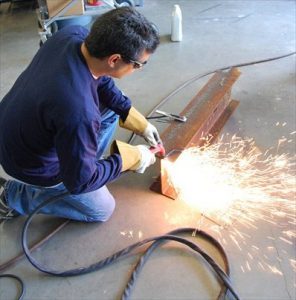 Despite plasma cutting being such a versatile process, it is a very easy one and can be learned by anybody. This has contributed massively to its popularity, and handheld models of plasma cutters are very common in small workshops. Here is a quick guide on how to use one of those cutters like this one: plasmacutterpro.com/hypertherm-088016-powermax-45-plasma-cutter-review/.
Despite plasma cutting being such a versatile process, it is a very easy one and can be learned by anybody. This has contributed massively to its popularity, and handheld models of plasma cutters are very common in small workshops. Here is a quick guide on how to use one of those cutters like this one: plasmacutterpro.com/hypertherm-088016-powermax-45-plasma-cutter-review/.
- Connect the air supply
Since plasma cutting needs a steady flow of compressed air, a reasonably powerful compressor is a must especially for larger projects. Make a secure connection between the compressor and the cutter.
- Ground the work piece
For the actual cutting, first you need to select a safe work surface (a grilled surface is ideal). Then, after placing the work piece on it, connect the work piece to the ground clamp. This is essential to establish a circuit and allow the current to flow between your cutter and the work piece. Make sure to connect the clamp fairly close to where you want the desired cut.
- Set the proper value for current
Depending on the thickness of the metal and the type of cut required, you need to set the correct value of current for the arc. Since the current directly affects the quality of the end product, make sure that you are confident about the settings.
- Position the cutter properly
Usually, the cutter needs to be held about 1/8th of an inch away from the surface of the metal. Make sure that you are positioned correctly to ensure a smooth cut. Also, the head of the cutter needs to be pointed vertically downwards at all times, i.e. making a 90 degree angle with the surface of the metal.
- Start the process
Once you are ready to begin, pull the trigger of the device. Compressed air will flow out for a few seconds and then the pilot arc will start. Ensure that the airflow is up to requirements. Once the arc starts, adjust the speed so that the sparks go through the metal and come out of the bottom side. If it is unable to penetrate the metal, then you might need to adjust the amperage and also check whether you are holding the device correctly. Also make sure that the thickness of the metal does not exceed the capacity of your cutter.
- Process control
Since it is a highly skilled process, the operator needs to be careful when moving the nozzle. If a particular type of cut is required (circular, angled) then make sure to move the arc gradually along the desired path. Longer cuts are harder to make be sure that you can make them without requiring any changes in position.
At the end of a cut (especially when completely severing two pieces), spend a little extra time at that spot to make sure that the cut is clean.